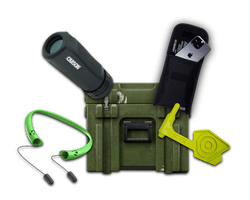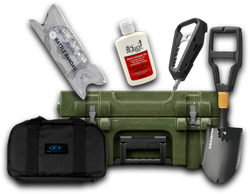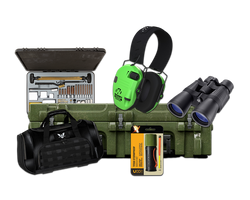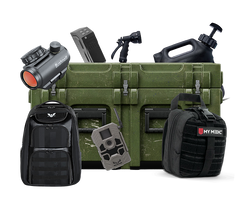
Tactical Rope Work: Knots and Techniques for Various Applications
Rope work is a fundamental skill in various fields, from camping and hiking to rescue operations and tactical situations. The ability to tie a secure knot can make a significant difference in safety, efficiency, and effectiveness. This article will delve into the world of tactical rope work, providing a comprehensive guide on various knots and their applications. Whether you're a novice or a seasoned professional, understanding the basics of knots can enhance your tactical readiness and problem-solving abilities.
Understanding the Basics of Knots
Before diving into specific types of knots, it's essential to understand some basic terms and concepts. A knot, in its simplest form, is a method of fastening or securing linear material such as rope by tying or interweaving it. Knots have been used for thousands of years for countless purposes, from sailing and fishing to construction and decoration.
When it comes to tactical rope work, the choice of knot can depend on several factors, including the type and diameter of the rope, the intended use of the knot, and the conditions in which the knot will be used. Some knots are easy to tie and untie, while others are designed to be secure under heavy loads or adverse conditions.
Understanding the properties of different types of knots is crucial. Some knots, like the square knot, are designed to join two ropes together. Others, like the bowline, create a secure loop at the end of a rope. Stopper knots, like the figure-eight knot, are used to prevent the end of a rope from slipping through a device or knot. Friction hitches, like the Prusik knot, can slide along a rope when not under load, but grip tightly when loaded.
Essential Knots for Tactical Rope Work
There are countless types of knots, each with its unique properties and uses. However, a few key knots are particularly useful in tactical situations. These include:
Bowline: Known as the "king of knots," the bowline creates a fixed loop at the end of a rope. It's easy to tie and untie, even after being loaded, making it ideal for rescue operations. The bowline is often used to secure a rope around a person's waist or to create a loop in the end of a rope for attaching a carabiner.
Square Knot (Reef Knot): The square knot is a simple and effective way to join two ropes of equal diameter. It's easy to tie and untie, but it should not be used in situations where it can be jostled or tugged, as it can slip or come undone. The square knot is often used for tying bandages or packages.
Figure-Eight Knot: The figure-eight knot is a stopper knot used to prevent the end of a rope from slipping through a device or knot. It's also the basis for the figure-eight follow-through, a popular knot for tying into a climbing harness. The figure-eight knot is known for its strength and stability, making it a reliable choice for various applications.
Clove Hitch: The clove hitch is a versatile knot that can be easily adjusted or untied. It's commonly used to start and end lashings, secure a rope to a tree or post, or create an anchor point in rescue operations. The clove hitch is quick to tie and can be tied with one hand, making it a practical choice in many situations.
Prusik Knot: The Prusik knot is a friction hitch that can be used to ascend or descend a rope in rescue operations. It's tied with a loop of cord around a rope and will slide when not under load, but grip tightly when loaded. The Prusik knot is a valuable tool in climbing and rescue operations, allowing for movement along a rope while maintaining safety.
Choosing and Caring for Your Rope
The type of rope you choose for tactical rope work can significantly impact its performance and longevity. Factors to consider when choosing a rope include its strength, flexibility, weight, and resistance to environmental factors like water, UV light, and abrasion.
When choosing a rope, consider its intended use. Static ropes, which have low stretch, are ideal for hauling loads or rappelling. Dynamic ropes, which have high stretch, are used for climbing to absorb the impact of a fall.
Once you've chosen a rope, proper care and maintenance are crucial to ensure it remains in good condition. This includes regular inspections for signs of wear or damage, proper cleaning and drying to prevent mildew or rot, and correct storage to avoid kinks or tangles.
Practical Applications of Tactical Rope Work
Tactical rope work has a wide range of applications, from everyday tasks to emergency situations. Here are a few examples:
Rescue Operations: Rope work is essential in many rescue operations, from mountain rescues to swiftwater rescues. Knots can be used to secure a victim, create anchor points, or build a pulley system for hauling.
Camping and Hiking: Basic knots can be used for setting up a tent, hanging a bear bag, or securing gear to a backpack. Knowing how to tie a secure knot can make your camping or hiking experience safer and more enjoyable.
Climbing and Rappelling: Rope work is fundamental in climbing and rappelling, whether it's tying into a harness, setting up an anchor, or creating a belay system. Understanding the properties of different knots can help you choose the right knot for the situation, enhancing your safety and efficiency.
Bushcraft and Survival: In a survival situation, knots can be used for building shelters, setting traps, or creating tools and weapons. A well-tied knot can be a valuable tool in a survival situation, providing a means of securing, fastening, or lifting.
Sailing and Boating: Knots are an essential part of sailing and boating, used for everything from securing sails to anchoring a boat. Knowing how to tie a variety of knots can make you more effective and efficient on the water.
Construction and Rigging: Knots are used in construction and rigging to lift and secure loads, fasten lines, and create tension. A well-tied knot can provide strength and stability, making it a valuable tool in these fields.
Learning and Practicing Knots
Learning to tie knots can be a fun and rewarding skill. There are many resources available, from books and websites to videos and apps, that can guide you through the process of tying various knots. Practice is key when learning to tie knots. Start with a simple knot, like the square knot, and practice it until you can tie it quickly and correctly. Then move on to more complex knots, practicing each one until you're confident in your ability to tie it.
When practicing knots, it's important to inspect your work. Make sure the knot is tied correctly and securely. Test the knot under load to ensure it holds. And practice untying the knot as well – in many situations, being able to quickly and easily untie a knot is just as important as being able to tie it.
Conclusion
Mastering the art of tactical rope work is a journey of continuous learning and practice. Whether you're tying a simple square knot or a complex rescue system, each knot is a tool that can enhance your capabilities and readiness. So grab a piece of rope and start practicing – you never know when these skills might come in handy. Remember, the best knot is the one that holds, so don't be afraid to experiment, adapt, and evolve your rope work skills over time. Stay prepared, stay ready, and embrace the tactical lifestyle.
Photo by Bella White
Share this article








